It’s 2022, and we’re living through a hot-hatch renaissance. Some might think it’s the 1980s all over again, given how spoiled we’ve been in these past five years. Whether it’s Honda’s mighty Civic Type R, Toyota’s unrelenting GR Yaris, and Volkswagen’s unsuspectingly lethal Golf R, the segment offers some of my favourite new cars today.
Hyundai was in the game early, offering us their raucous i30N back in 2016. To this day, it’s still one of the best sounding hot-hatches available. Today, Hyundai has expanded their N performance line-up, which now includes the Kona N SUV and the i20N.
The i20N is Hyundai’s cruiserweight, intended to square off against the likes of the upcoming Ford Fiesta ST. Hyundai themselves call the i20N, the “corner rascal”.
So, strap in, turn on the synth-wave and fix your fro, DriveLife will tell you all about living with the i20N.

What We Like and Dislike About The 2022 Hyundai i20N
| What we like | What we don’t like |
| Brisk performance Board range of torque Playful chassis Excellent handling Good standard equipment list Determined looks Software configurability and easter-eggs The noise! | Somewhat bland interior Engine not the most rev-happy Slightly noisy cabin Not much else of note… |

What’s In The 2022 Hyundai i20N range?
There’s only one model of Hyundai i20N available, which retails for $53,990. Funnily enough, Hyundai doesn’t sell the i20 in New Zealand anymore, which is the very car the i20N is based on.
The i20N is powered by a 1.6-litre, 4-cylinder turbocharged petrol engine output of 150kW of power and 275Nm of torque (or 304Nm on overboost). The engine is paired with a 6-speed manual transmission, powering the front wheels (FWD).
2022 Hyundai i20N Standard Equipment Highlights
As standard for the i20N, you get:
- 18’’ Alloys,
- 10.25″ infotainment w Bluetooth, Sat-nav, Apple CarPlay and Android Auto
- 10.25″ colour TFT driver information display
- 8-speaker Bose audio system plus Amp
- Reverse Camera
- Single-zone climate control
- 6-way manually adjusted driver’s seat
- 4-way manually adjusted passengers seat
- Cloth Interior
- Electro-chromatic rear-view Mirror
- Front and Rear parking sensors
- Heated and electronically folding side mirrors
- LED headlights, tail lights and Daytime Running Lights
- Rear spoiler with LED stop light
- Front & rear USB inputs
- Wireless Charger
- N-Performance body kit
- N Performance Driving Data System
- N-Steering wheel and gear shifter
- Alloy pedals
The i20N features a long list of safety technology, including:
- 6 Airbags
- Electronic Stability Control + Traction Control System + Vehicle Stability Management
- Forward Collision Avoidance
- Lane Keeping Assist
- Blind-spot Collision Warning
- Rear Cross-traffic Collision Warning
- Driver Attention Warning
- High Beam Assist + Automatic dusk sensing headlights
- Rear Occupant Alert and ISOFIX
There are seven colour options for the i20N. Our test vehicle is wearing Hyundai’s signature Performance Blue paint.
- Performance Blue
- Sleek Silver
- Polar White
- Brass (Deeper Silver)
- Dragon Red
- Intense Blue (Deep Blue)
- Phantom Black
All colours come with a contrasting black roof and side mirrors.
For more information on the i20N, check out the Hyundai New Zealand website.


How Does The 2022 Hyundai i20N Compare To Its Competition?
The Hyundai i20N has few natural predators at the moment. The 2022 Ford Fiesta ST is yet to arrive on New Zealand shores. The Volkswagen Polo GTi is still around, but not for long. As for the Toyota GR Yaris, good luck finding one for less than $60,000.
| Make/ Model | Engine | Power/Torque kW/Nm | 0-100km/h, seconds | Fuel, L/100km | BootSpace, litres | Price |
| Toyota GR Yaris | 1.6L 3-cylinder turbo | 200/370 | 5.2 | 7.6 | 174 | POA |
| Hyundai i20N | 1.6L 4-cylinder turbo | 150/304 | 6.3 | 7.7 | 310 | $53,990 |
| Volkswagen Polo GTI | 2.0L 4-cylinder turbo | 147/320 | 6.5 | 6.8 | 305 | $40,990 |
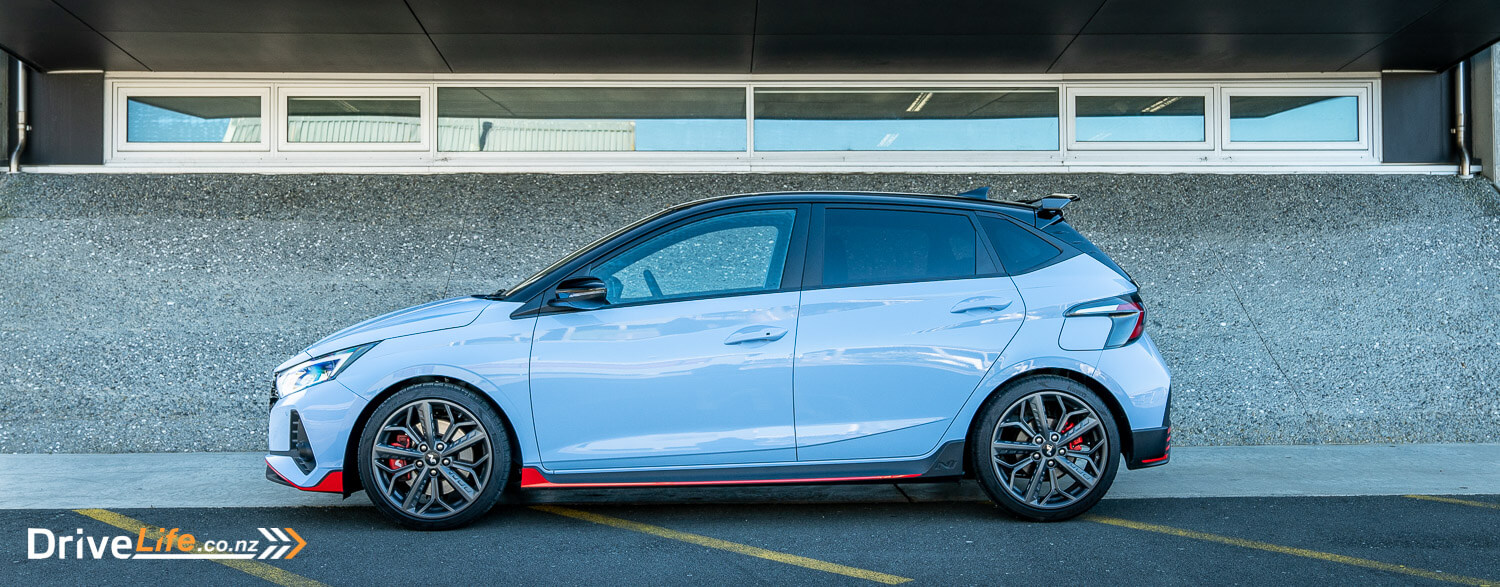
First Impressions Of The 2022 Hyundai i20N
Even before I could get behind the wheel, the i20N already had me grinning. The large 18’’ alloys filling the arches, sharp body lines, the aggressive body kit with lashings of red, and the rear roof-spoiler all demonstrates the i20N’s plucky attitude.
Our car is wearing Hyundai’s sweet Performance Blue Paint job too, which is definitely the colour to have.

What’s The Interior Like In The 2022 Hyundai i20N?
When you consider that an i20N is a budget-conscious performance car derived from an economy car, you ought not set your standards too high for the interior. That’s to say the cabin isn’t particularly plush.
There’s plenty of sculpted black plastics, black upholstered seats, along with a black roof lining. Short of some contrast blue stitching, there’s few immediate give-aways that you’re in something special.

Granted, this interior is far from cheap. The plastics are of reasonable quality, and it’s all assembled together tightly. The cabin does get fairly dark between all the black trims. Fortunately, Hyundai off-sets this with some integrated performance blue LED strip lighting through-out the cabin.
The equipment list is also generous given the price point, with features such as dual screen infotainment and dash cluster, wireless phone charger, an electro-chromatic rear-view mirror and a suite of safety kit all standard. I gotta give genuine credit to Hyundai for not cheaping out in the name of weight savings.

All of the best interior features are directly in front of the driver. The steering wheel is one of them, adorned with two big Blue “N” buttons, and a red button which says “REV” to excite the inner-man child.
There’s a subtle difference between those two blue N buttons. One side allows you to flick between three different drive modes, being Eco, Normal and Sport. Click the other side, the i20N goes directly into N-mode. Another click puts you into your own custom mode.
The big red “REV” button is to control the rev-matching, if that wasn’t obvious. Rev-matching is switched-on by default in Sport and N-Mode, but switched-off in Normal and Eco. Personally, I liked having it on when doing the daily commute, so it’s quite handy having it right there.

The digital dash is another star of the i20N’s interior. Sure, it might be a modified version of Hyundai’s standard system, but it’s nonetheless an excellent unit. The resolution is sharp, as are the graphics, colour and contrast ratios.
The i20N’s 10.25’’ infotainment system is also another carry-over Hyundai component, but it’s a similar story to the digital cluster. The system is great, with good resolution, a simply understood user interface, and good on-screen graphics. It’s considerably better than much of the competition.
The unit is connected to a 8-speaker Bose Audio system. The Bose system has its usual hallmarks, delivering a conventionally warm sound. However, lower, bassier notes aren’t captured particularly well. It’s the usual Bose stuff, which is good but not great.
Small gripes aside, between the digital dash, infotainment and name-brand audio, it’s quite a generous technology package for a budget-conscious performance car. There’s even a wireless charger in the centre console. Just be aware, it doesn’t fit a Samsung S20 Plus in a case. My S10 in a case was fine, however.
I had briefly mentioned front seats earlier. Hyundai calls these the N-sports seats. They wear black upholstery, contrasted with performance blue stitching and some graphics on the seat backs. The integrated headrests give them a bucket-seat look. They’re quite firm, but not uncomfortable, and they are well-bolstered enough for faster cornering. Importantly, the driving position isn’t too high up, like it is in the GR Yaris.

While i20N’s short dimensions might make you think the rear passengers are in for a bad time, you’d be pleasantly surprised. There’s enough head and legroom for adults to get comfortable on short journeys. Heck, even John with his lofty 6ft 7’’ stature even remarked that it wasn’t too bad. Granted, he wasn’t in there long. In reality, you’ll still want to strategically plan your passenger swaps on longer trips.
Around the back, the boot is also surprisingly generous for the i20N’s compact size. The wee Hyundai offers 310L of space with the rear seats up, and up to 1,123L with the rear seats down. Hyundai has even managed to smuggle a space saver tyre under the floor, which is a quality that few hot-hatches can boast.
See! You can tell your partner it’s practical.

What’s The 2022 Hyundai i20N Like To Drive?
We’ve never been more spoiled for horsepower in our current era. Spend an evening browsing YouTube, and it’ll seem that every second influencer is rolling around in some concoction with over 1,000 horsepower. It’s all slightly jading, if I’m honest, and it does cars like the Hyundai i20N a disservice.
The i20N’s 1.6-litre turbocharged 4-cylinder outputs 150kW of power and a maximum of 304Nm of torque. Hardly anything worth bragging about, these days.
The slightly more attentive may point out that the i20N’s engine is a re-worked version of the same unit found in the Hyundai i30 N-line. Again, nothing to brag about.
So, it might be easy to glaze-over the Hyundai i20N’s spec-sheet. Although, I pity the fool that does.

If anything, once you’ve been behind the wheel for more than 5 minutes, you won’t care about the numbers. Heck, you mightn’t even believe them. Remember for a moment that the Hyundai i20N only tips the scales at a mere 1,235kg. Add 150kW and 304Nm to a light frame, and those figures will feel like understatement.
The i20N has plenty to show down-low. Bury the throttle from standstill, the i20N will move forward with proper pace. The 1.6-litre turbo has been tuned for broad torque, offering 275Nm produced from 1,750 to 4,500rpm, and 304Nm available on overboost. To assist this, Hyundai’s engineers have integrated “Virtual Turbo-speed Control”, which uses computers to control the turbocharger’s wastegate pressure on the fly to reduce lag.

With this amount of torque-on-tap, punting the throttle will cause the i20N to depart with a grin-worthy amount of axle tramp. Once the tyres have gripped, it’ll pull strongly through the mid-range, and will only begin to run-out of puff when you push north of 5000rpm.
This might be the baby of the N range, but make no mistake, the i20N has plenty of pace.
Then, there’s the noise. Short of Hyundai’s own i30N, there’s no other new hot hatch I’ve encountered which sounds this good. Drop the i20N into N-mode, and it’ll produce some fruity noises out the back. Heck, it’ll even spit out some little backfires on the overrun, albeit in a relatively controlled manner. I suppose it’s good for maintaining a relationship with your neighbours.

Speaking of N-Mode, the i20N’s different five drive modes configure the steering, engine response, exhaust noise, aggressiveness of the rev-matching, and also the stability programme nannies too. N-Mode does make the i20N noticeably more potent, with better responsiveness, throatier exhaust, and weighted-up steering. The infotainment even allows you to set the engine RPM for launch control too.
Switching between drive modes also changes the dash cluster graphics. N-Mode has its own unique arrangement, which includes all the track telemetry tools which you’ll frequently want to show-off.
Of course, nothing is perfect. The turbo 4-banger is not the most rev-happy powerplant. It takes slightly longer than you’d expect to build revs, indicating the i20N is sporting a rather heavy flywheel. I also noticed a bit of rev-hang shifting up between gears. Occasionally, it was enough to give you a jolt through your seat.

The i20N comes standard with a slick 6-speed manual transmission. The box has a short throw and a satisfying mechanical feel. Although, it’s nothing quite as sharp and satisfying as the gearbox in a Honda Civic Type R.
The clutch is weighted just right too. Enough to feel engaging, without being a pain in slow traffic.
Hyundai also has the rev-matching working absolutely seamlessly. Although I like to do things the old-fashioned, heel ’n’ toe sort of way, the auto-blip really does add to the experience. It’s great for when you’re learning the i20N’s limits, and also incredibly useful for just pottering around town too. Also, that red ‘REV’ button on the steering wheel is just too damn cool for my inner 9-year-old to ignore.

Between the entertaining turbocharged engine and the slick manual transmission, the i20N already has the performance to put a smirk on your face. But, this i20N true self starts to shine when you head for a twisty road.
Underneath, the i20N is beefed up with stiffer springs and more aggressive dampers. There’s larger anti-roll-bars and a generous helping of chassis bracing all round. A front Limited Slip Differential, called the “N Corner Carving Diff” is standard.
The results? Well, the i20N is Hyundai’s self-proclaimed “corner rascal” for a reason. The chassis is playful, with natural turn-in and rotation. Push hard into a corner, and the body remains remarkably flat, only introducing a gentle lean when you push hard on the boundaries.
Even when you’re at the edge of physics, the i20N’s front diff and sticky Pirelli tyres gives you the confidence that the front end won’t wash out. The i20 neatly holds its line, even if you’re overzealous with the throttle.

Granted, the i20N is not the best handling hot hatch you’ll drive. But that’s not the point. The i20N savours a corner, rather than attacks it.
You can get into some seriously impressive performance cars these days, which are designed specifically to obliterate corners. But honestly, many of them wouldn’t be nearly as nearly as fun as the i20N when you’re deliberately taking the long way home.
The size of the i20N is also perfect for our roads too. At just over 4 metres long and under 1.8 metres wide, the i20N is a throwback to when cars weren’t humongous. Some hot hatches can verge on being too big for this country’s tight backroads, whereas the i20N sits right in the goldilocks zone.
Braking feel is great too, and Hyundai reckons you can give them a good thrashing on the track before you’ll encounter any major fading.
Between all the extra handling upgrades, the i20N’s ride quality is naturally firm. There’s also not a great deal of sound deadening in the cabin. There’s a fair amount of tyre noise, owing to those grippy Pirellis. This, and you’ll also notice some wind-blast too.
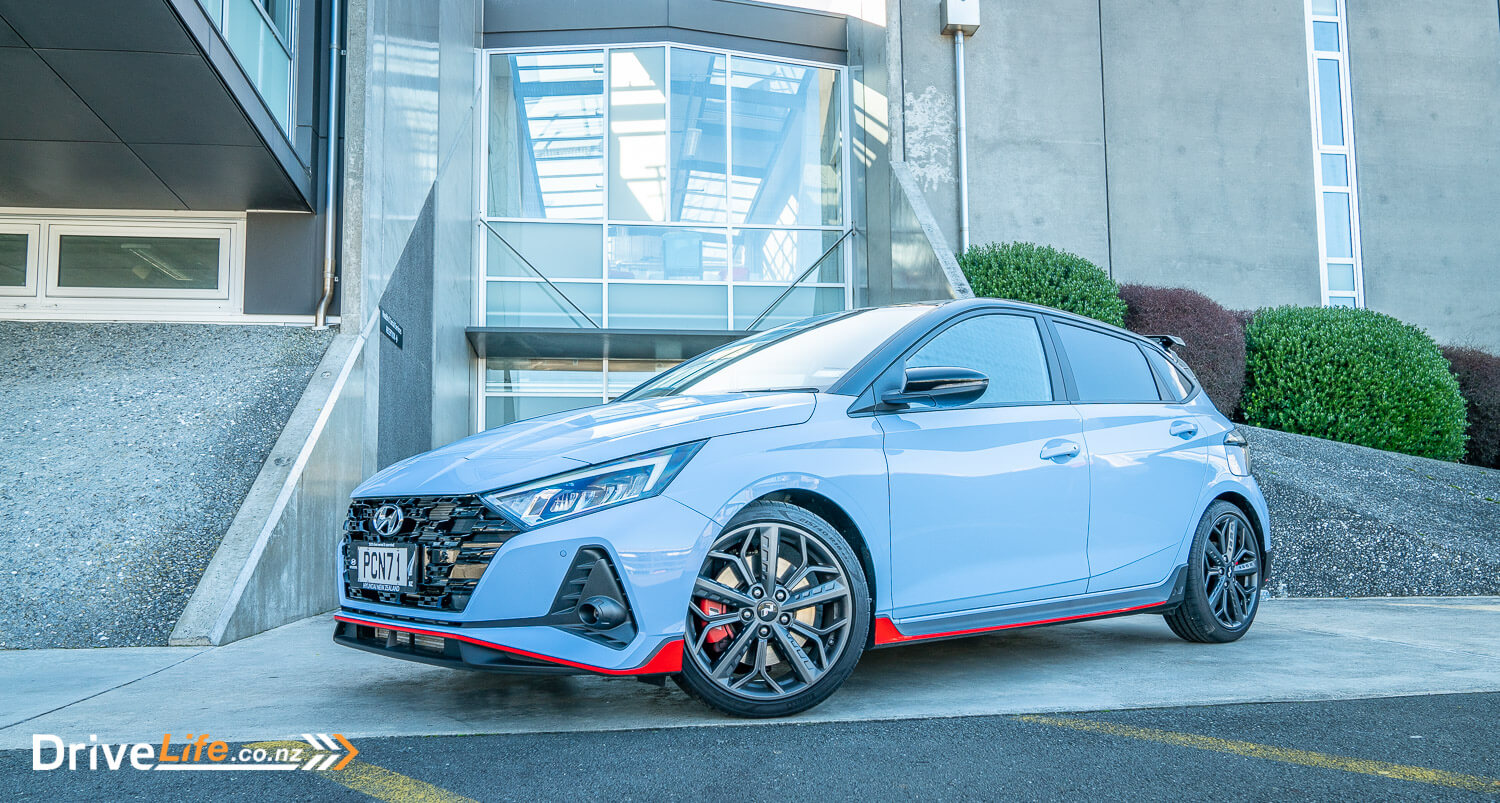
Although, none of these qualities are deal breakers. The i20N is perfectly liveable for those interested in daily-ing the I20N. Despite the stiff dampeners, the i20N manages bumps well without being too crashy. And heck, with an exhaust note like the one coming out of the i20N, the less sound-deadening, the better.
How about fuel consumption? Well, let’s just say it’s not the i20N’s priority, especially when you’ve been driving it like we had. The claimed figures aren’t bad. The i20N has a claimed fuel consumption figure of 7.7L per 100kms (combined). If you’re just pottering about, this is definitely achievable. We got 9.1L per 100kms during our week with the i20N. Told you we had fun.

While it’s an overused automotive journalist cliché to say that the car encourages you to drive it faster, the i20N is probably the first car where this is literally true.
The GPS detects when you’re approaching a twisty section, and will prompt you via the dash cluster “S-bend ahead, turn on N-mode”. The i20N literally encourages you to be a hoon. It’s brilliant.
I can imagine the engineer in Namyang who managed to sneak that little easter-egg into the I20N’s programming is still grinning. Also, as standard with any Hyundai, the GPS will also call out upcoming fixed speed cameras too. However, I often found it would quote the wrong speed limit when passing a few known camera spots.
Any other driver’s assistance tech worth noting? Well, there’s no adaptive cruise, just traditional cruise control. The i20N does have lane centring assistance, which works fine. But honestly, for many drivers, this button will just gather dust.
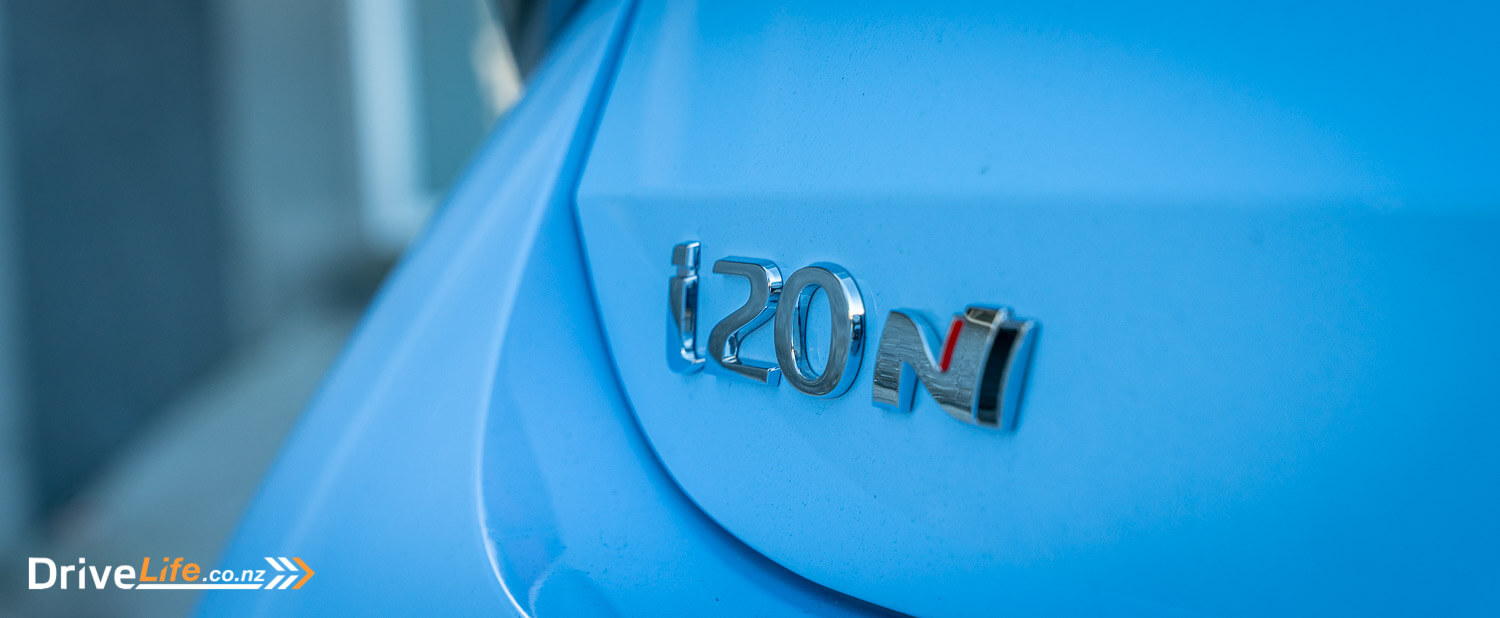
2022 Hyundai i20N Specifications
| Vehicle Type | Performance Hatch |
| Starting Price | $53,990 |
| Price as Tested | $53,990 |
| Engine | 1.6-litre turbo 4-cylinder |
| Power, Torque kW/Nm | 150/275 (304Nm on Overboost) |
| Acceleration, 0-100km/h, Seconds | 6.3 |
| Transmission | 6-speed manual |
| Spare Wheel | Space saver |
| Kerb Weight, Kg | 1,235 |
| Length x Width x Height (mm) | 4075 x 1775 x 1440 |
| Boot Space / Cargo Capacity, Litres (seats up/seats down) | 310 (second row in-place) 1,123 (second row down) |
| Fuel tank capacity, Litres | 40 |
| Fuel Economy, L/100km | Advertised Spec – Combined – 7.7 Real-World Test – Combined – 9.1 Low Usage: 0-6 / Medium Usage 6-12 / High Usage 12+ |
| Towing Capacity Kg, unbraked/braked | N/A |
| Turning circle Metres | 10.5 Small: 6-10m / Medium 10-12m / Large 12m+ |
| Warranty | 3 year/100,000km mechanical warranty 3 year/100,000km roadside assistance 10 year/200,000km anti perforation corrosion body warranty |
| Safety information | ANCAP Rating – Not tested Rightcar.govt.nz – 4 Stars – PCN71 |
Have you enjoyed this review? Be sure to join our monthly email newsletter list so you don’t miss a single car review!










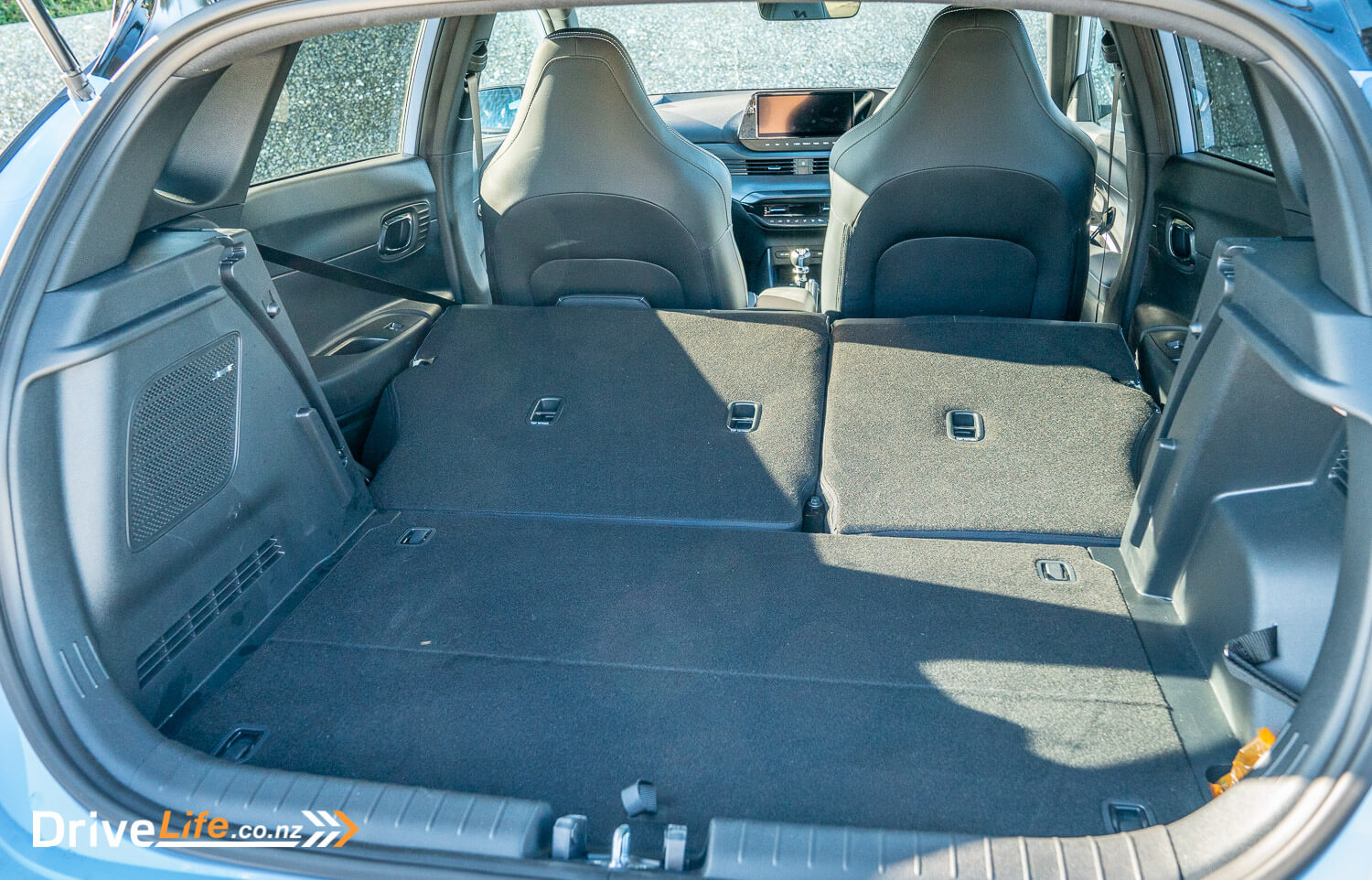
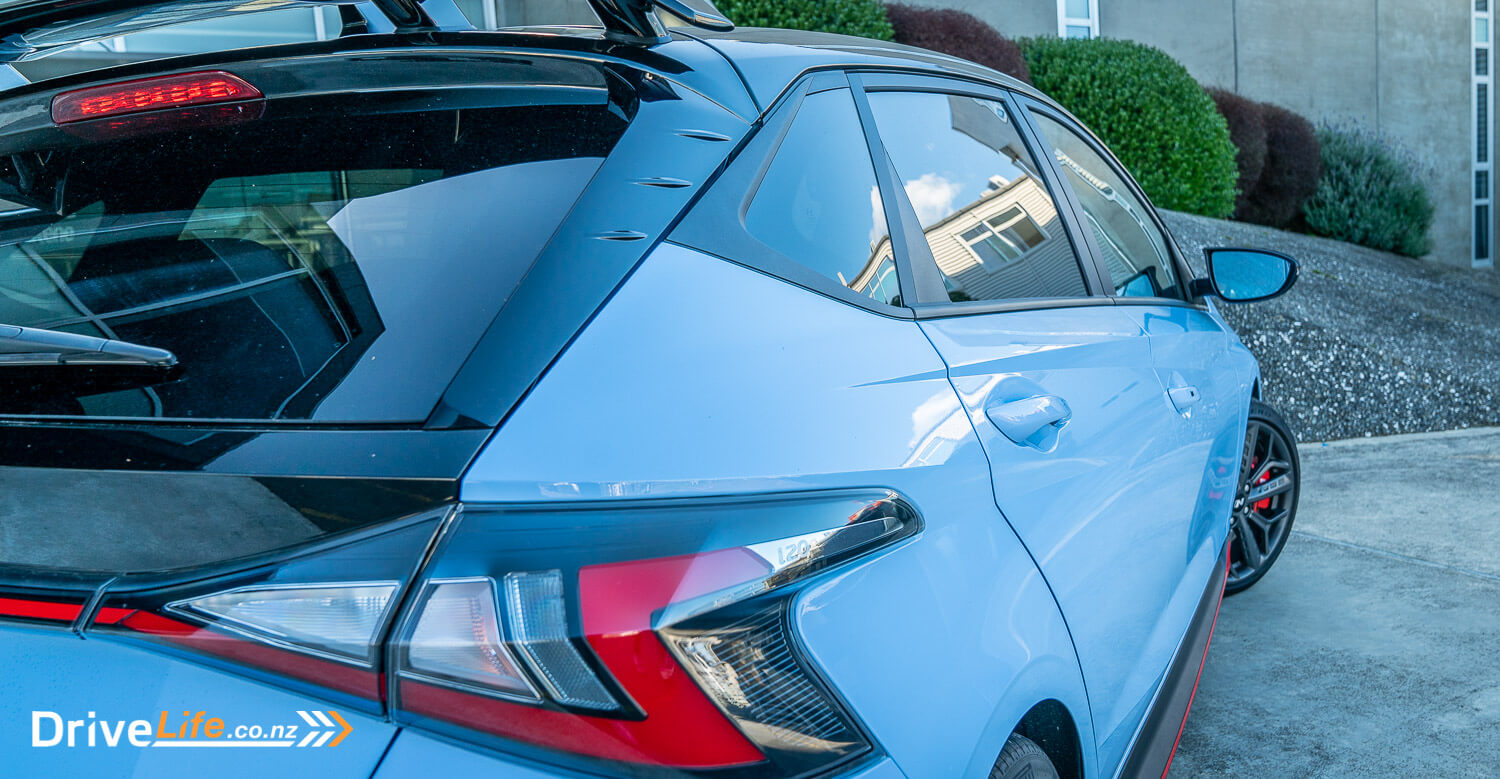












































$54k ???
Is Hyundai on crack pricing this $10k more than the competition.
so much cheaper in aussie too..